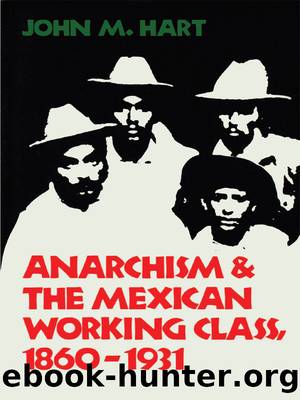Anarchism & The Mexican Working Class, 1860-1931 by John M. Hart

Author:John M. Hart
Language: eng
Format: epub
Tags: -
Publisher: University of Texas Press
Published: 2011-09-09T16:00:00+00:00
9. The Casa del Obrero Mundial and the Constitutionalists
After the defeat of Huerta, the Constitutionalist forces loyal to Venustiano Carranza and Alvaro Obregón moved quickly to recruit urban labor support against their provincial rivals led by Francisco Villa and Emiliano Zapata. The active diplomacy of Obregón became the most effective link between the Constitutionalists and the organized working class.
The Treaty of Teoloyucan, signed on August 15,1914, formally transferred political authority to the Constitutionalists and permitted the peaceful entry of Obregón’s troops into Mexico City. Because of Huerta’s closure of Emancipación Obrera and Casa headquarters, the Lucha leadership group regarded the arrival of the Constitutionalists as the “liberation” of Mexico City and hailed the Constitutionalists, some of them quite radical, as the “liberators.” On August 20, the date of Carranza’s triumphal entry, Lucha leaders held a “liberation celebration” at Casa headquarters. The new government sent a sizable contingent of representatives noted for their prolabor sympathies to the ceremony, including ex-Magonista Antonio I. Villareal. The assembled Casa members and their guests then heard a series of discourses on “proletarian revolution” and anarchosyndicalism delivered by Roldán, Huitrón, de la Vega, de la Colina, and others. The government delegates did not appear intimidated by the radical rhetoric of the Casa leadership and assured the assembled workers of the social nature of the Constitutionalist revolution and that the desperately poor living conditions and food shortages experienced by the urban workers were the primary concerns of the new government. They called for working-class support for the “Revolutionary Government” which they claimed acted on organized labor’s behalf.1
On September 26, Obregón followed up these initial contacts with the Casa by donating to it the building of the former Jesuit convent of Santa Brígida as a meeting place. The Casa accepted the gift, and in less than five weeks the urban labor leaders seriously compromised their ideological pledges of nonpolitical involvement. The close working relationship established by Obregón with the Casa, the unusual political conditions that prevailed, and an openly sympathetic government overruled allegiance to an unmodified anarchosyndicalism. Cooperation with Obregón, under what they believed to be their own terms and exercized in their own interests, seemed advantageous to both rank-and-file members and a majority of the Casa leadership.
In the fervor of “liberation,” anarchosyndicalist leaders who later disavowed the Regional Confederation of Mexican Workers (CROM), because of “government domination,” accepted Obregón’s gift, apparently without dissent. Because of difficult conditions, anarchists considered the acceptance of such donations from a supportive government to be wise and not necessarily compromising.2 From the Constitutionalist government’s point of view, urban labor constituted a sizable and potentially powerful force. The donations cost the government little and they helped create good will among urban workers.
The reopening of the Casa in late August 1914 precipitated an intense organizing campaign in which Lucha representatives visited factories and artisan shops in Mexico City, Guadalajara, Monterrey, and the other principal centers of industry nationwide. The basis for the reconstruction of the Casa was prepared during its months of banishment under
Download
This site does not store any files on its server. We only index and link to content provided by other sites. Please contact the content providers to delete copyright contents if any and email us, we'll remove relevant links or contents immediately.
| Elections & Political Process | Ideologies & Doctrines |
| International & World Politics | Political Science |
| Public Affairs & Policy | Specific Topics |
| United States |
The Secret History by Donna Tartt(18188)
The Social Justice Warrior Handbook by Lisa De Pasquale(11957)
Thirteen Reasons Why by Jay Asher(8461)
This Is How You Lose Her by Junot Diaz(6452)
Weapons of Math Destruction by Cathy O'Neil(5842)
Zero to One by Peter Thiel(5498)
Beartown by Fredrik Backman(5369)
The Myth of the Strong Leader by Archie Brown(5243)
The Fire Next Time by James Baldwin(5024)
How Democracies Die by Steven Levitsky & Daniel Ziblatt(4966)
Promise Me, Dad by Joe Biden(4912)
Stone's Rules by Roger Stone(4867)
100 Deadly Skills by Clint Emerson(4695)
A Higher Loyalty: Truth, Lies, and Leadership by James Comey(4557)
Rise and Kill First by Ronen Bergman(4548)
Secrecy World by Jake Bernstein(4394)
The David Icke Guide to the Global Conspiracy (and how to end it) by David Icke(4386)
The Farm by Tom Rob Smith(4329)
The Doomsday Machine by Daniel Ellsberg(4250)
